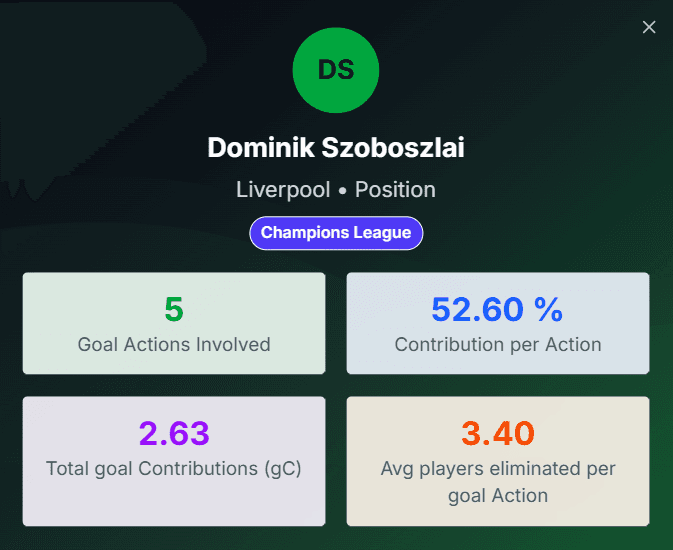
Kane, Haaland, Mbappé: The 5-Goal illusion: Why gC tells a different champions league story
After four matchdays in the 2024/25 UEFA Champions League, three names dominate the headlines:
Kylian Mbappé, Erling Haaland, and Harry Kane — each sitting proudly with five goals to their name.
Five goals in four games. A perfect narrative for the football media machine.
But when you look through the lens of Goal Contribution (gC), the reality flips upside down.
The Numbers Behind the Hype
All three strikers have scored five times, but their total gC tells us who actually creates the goals — not just finishes them.
- Harry Kane: 2.42 gC (≈ 48.4% personal contribution per goal)
- Erling Haaland: 2.06 gC (≈ 41.2%)
- Kylian Mbappé: 1.68 gC (≈ 33.6%, partly explained by his three penalties)
So even among Europe’s elite finishers, Kane stands out — not just for scoring, but for how much of the goal he builds himself.
Meanwhile, Mbappé’s 33.6% shows a player highly efficient at finishing, but less involved in the creation of the play leading up to it.

When the Storyline Doesn’t Match the Data
The popular narrative already places these three forwards among the Ballon d’Or frontrunners.
Every headline reads the same: “Most decisive players in Europe.”
But when viewed through the prism of gC, this narrative starts to crumble.
Despite their scoring records, none of the three are actually among the most decisive players in the Champions League so far.
Here is a trio of names that rarely make the highlight reels:
- Nuno Mendes (PSG) – 2.51 gC from 6 goal actions and just 2 goals
- Michael Olise (Bayern) – 2.45 gC from 8 goal actions and only 1 goal
- Dominik Szoboszlai (Liverpool) – 2.63 gC from 5 goal actions and 1 goal

In other words, players with fewer goals are contributing more to the goals. They are decisive contributors without being finishers.
Rethinking “Decisive”
These numbers show how limited our traditional interpretation of “decisiveness” can be.
A five-goal striker is impressive — but what if another player helped build eight different goals, eliminating defenders, creating space, and driving progression?
That’s where gC changes the game.
It values the entire goal-scoring sequence, quantifying how much a player actually contributes to the team’s ability to score — not just the final touch.
So while Kane, Haaland, and Mbappé headline the highlight reels, the real influence lies deeper in the play — with players like Mendes, Olise, and Szoboszlai quietly shaping every attacking pattern.
Sure, we’re only halfway through the group stage — plenty of football left to play.
But the early trend is clear: the most decisive players aren’t necessarily the top scorers.
As the media narrative around the Ballon d’Or begins to take shape, the usual bias resurfaces —
goal scorers dominate perception, while creators and facilitators fade into the background.
Why It Matters
This isn’t just about one dataset — it’s about the way football measures impact.
The gC metric doesn’t ignore goals; it contextualizes them.
It rewards the intelligence, timing, and creativity that make goals possible.
Because sometimes, the most decisive player isn’t the one who scores —
it’s the one who made the goal happen.
